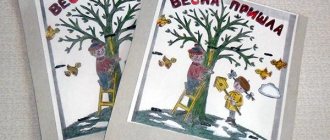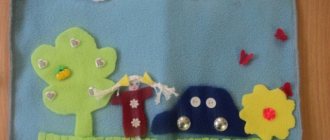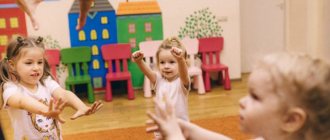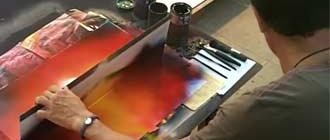Traveling along the ecological trail
Municipal preschool educational institution "Kindergarten No. 83 of a combined type"
PLAN-OUTLINE
integrated lesson walking along the ecological health trail “Zimushka-winter”
Prepared by:
teacher
first qualification category Mashkova N.F.
Saransk, 2018
Tasks:
- Show children the state of nature in winter; trees and bushes are at rest, without leaves, the ground is covered with snow);
- Continue to introduce winter phenomena in inanimate nature (ice, snowfall, snowdrifts).
- To form the idea that life continues in winter, to consolidate knowledge about the ways plants and animals adapt to winter.
- Develop observation skills and the ability to make basic generalizations.
- Improve the technique of breathing exercises in frosty air.
- To promote the development of an emotionally holistic relationship with nature.
Materials:
- map of the ecological health trail, signs.
PROGRESS OF THE CLASS
Before going outside, the teacher announces to the children that they will now go on a journey along an ecological trail and observe what has changed with the arrival of winter.
While walking, you can use specially selected speeches, combining the rhythm of speech with the rhythm of movements.
Let everything be covered with snow,
Let the cold rage
Winter won't freeze me
It will never scare you.
Educator:
Children, tell me, what has changed in our clothes? That's right, it got cold outside, so we dressed warmly! And now I’ll ask you to guess the riddle and say what time we’re talking about:
I swept everything around
Arriving from the Blizzard Kingdom!
Autumn, best friend
I sent it south!
I am frosty and white, I have come to you for a long time!
Children:
Winter!
Educator:
That's right, we are talking about winter. It has become cold, the sun appears less often, it shines, but does not warm.
We approach a tree, what is it called?
Children:
Thuja!
Educator:
That's right, guys, this is a thuja - an evergreen shrub, and sometimes a tree up to 70 meters high. Thuja belongs to the conifer family. It is unpretentious in care, so it grows on the territory of the kindergarten and delights us with its greenery both in the warm season and in the cold.
Now look at our flower bed! Where are our flowers?
Children:
They sleep under the snow.
Educator:
That's right, we removed the annual plants, and the perennial flowers were covered with a white blanket of snow. In the spring, when the sun begins to warm up, the snow melts, our flowers begin to sprout. And we will admire their beauty again!
Let's move on! On the right we are greeted by slender, tall, beautiful and evergreen spruce trees. Listen to the riddle:
One color in winter and summer.
That's right, of course, it's a Christmas tree. Its leaves are needles that do not fall off and always remain on the tree. And at the very top hang cones with tasty seeds, which is food for various birds that stayed with us for the winter.
Among the green spruces there is one of an unusual color, it is in the middle, pay attention. This is blue spruce, or, there is another name for it, prickly spruce. It is planted to decorate any buildings, for example, on Red Square near the Kremlin wall in Moscow, blue fir trees are planted in orderly rows.
Let's say goodbye to the Christmas trees and move on!
To our left there are two birch trees. Look, there are no leaves on the trees at all, the branches are bare. Why do you think?
Children:
The leaves fell in the fall.
Educator: That's right, in winter there are no leaves on the trees, the trees rest. A birch tree can be recognized by the color of its trunk. It is not for nothing that people call the birch the white-trunked beauty. You need to remember that the birch is a symbol of Russia. Does anyone know a poem about a birch tree?
Children:
White birch
Below my window
Covered myself with snow
Exactly silver.
Educator:
Well done, children, as the great Russian poet Sergei Yesenin wrote about the beautiful birch.
Let's move on! On the way we meet Kashtan Ivanovich, let's say hello to him, our old friend!
Children:
Hello, Kashtan Ivanovich!
Educator:
Children, what gifts did Kashtan Ivanovich give us in the fall?
Children:
Chestnuts.
Educator:
That's right, in the fall we collected chestnuts for crafts. Did you know that chestnuts can be fried and eaten!
Look, Kashtan Ivanovich hung up the feeder! And for whom?
Children:
For wintering birds!
Educator:
That's right, children, a feeder for wintering birds. What birds remained for the winter?
Children:
Sparrow, tit, crow, magpie, dove.
Educator:
Let's recite the poem "Bird's Dining Room":
We made a feeding trough, We opened a dining room. Sparrow, neighbor bullfinch, There will be lunch for you in winter.
On the first day of the week, tits came to visit us. And on Tuesday, look, the bullfinches arrived.
Three crows were there on Wednesday, We weren't expecting them for lunch. And on Thursday from all over the world - a flock of greedy sparrows.
On Friday, in our dining room, Golub enjoyed porridge. And on Saturday seven forty flew into the pie.
On Sunday, on Sunday, a spring guest flew to us - the starling traveler... That’s the end of the song.
Let's put some treats in the feeder and move on.
On the way we meet a stump. Let's get closer to him! What is this - a stump? Previously, children, this was a tree, they cut it down and what was left was this stump. Where do you think the inhabitants of this stump are now?
Children:
Residents hid under the bark.
Educator:
That's right, all the insects hid under the bark and are waiting for warm spring days. After all, in winter all insects sleep.
Go ahead. Carefully! There is an icy path on our way. She is very slippery. How did the ice path form?
Children:
There used to be a puddle here, but the frost hit and froze it.
Educator:
I suggest we go around it so as not to fall.
So we reached our site. It's time to play. Let's play the game "Winter-Winter".
Rules of the game: the teacher names the words and shows the movement, the children repeat, the teacher can confuse the children, the one who showed the wrong movement is eliminated.
Frost – stand still;
Blizzard - running in place;
Blizzard - squat;
Snow - spinning in place.
Children, when we return to the group, you and I will draw the most memorable objects on our ecological trail. It could be birch, spruce, stump, Kashtan Ivanovich with a feeder, thuja, etc.




